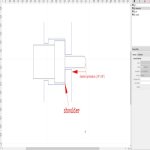Have had a nice (for it's age) exposed-hammer Belgian Guild SXS for a while now, bought it with both firing pins missing. A "friend with a lathe" was kind enough to devote his effort and time to make a couple of firing pins for it. Was not easy, apparently the two nipples differed in size, he had to spend a bit of time filing and refitting to get them in place. His efforts did not go unnoticed and were rewarded with the appropriate sized and quality liquor...
The new pins are in place, they slide in and out easily, no slop in the movement. My friend left both the hammer and pin ends intentionally long. Now it's up to me to appropriately size them by filing. First timer, so any advice would be welcome...
Here's how it looks with the pins in place and the hammer at full rest, hammer-end is long enough that it gets pushed-in by hammer...

Here's how it looks if I use a vise-grip and gently push the pin it, to a point where I guess it will end up looking like.

Here's what it looks like with the hammer cocked.

Here's what it looks like with my grubby, shriveled finger pushing the hammer as far forward as I can get it, around 1/16th ahead of hammer at rest.

And here is where my rapid-fire questions start... What distance should the face of the hammer be from the head of the firing pin, at rest (A)? How about the distance when fully pushed forward (B)?
I'm guessing that when the hammer strikes the pin head, it travels even further than the position I can push it forward to, at rest. I'm a wrong?

As for the pin end, I've read that it should protrude 50 to 60 thous past face when struck, I think I'll just deal with that part AFTER I determine the SAFE dimensions of the firing pin head.
Would appreciate any advice, especially with anyone who owns a similar vintage shotgun and would be kind enough to measure their own A and B distances.
The new pins are in place, they slide in and out easily, no slop in the movement. My friend left both the hammer and pin ends intentionally long. Now it's up to me to appropriately size them by filing. First timer, so any advice would be welcome...
Here's how it looks with the pins in place and the hammer at full rest, hammer-end is long enough that it gets pushed-in by hammer...

Here's how it looks if I use a vise-grip and gently push the pin it, to a point where I guess it will end up looking like.

Here's what it looks like with the hammer cocked.

Here's what it looks like with my grubby, shriveled finger pushing the hammer as far forward as I can get it, around 1/16th ahead of hammer at rest.

And here is where my rapid-fire questions start... What distance should the face of the hammer be from the head of the firing pin, at rest (A)? How about the distance when fully pushed forward (B)?
I'm guessing that when the hammer strikes the pin head, it travels even further than the position I can push it forward to, at rest. I'm a wrong?

As for the pin end, I've read that it should protrude 50 to 60 thous past face when struck, I think I'll just deal with that part AFTER I determine the SAFE dimensions of the firing pin head.
Would appreciate any advice, especially with anyone who owns a similar vintage shotgun and would be kind enough to measure their own A and B distances.
Last edited:








































































